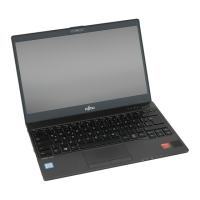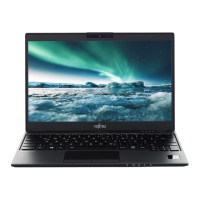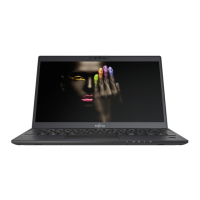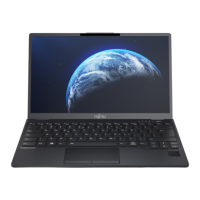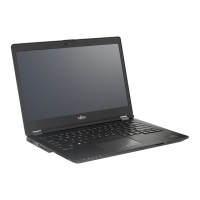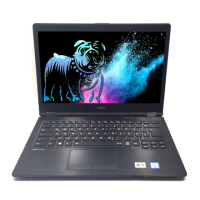How to correct date and time on a Fujitsu LIFEBOOK U904?
- MMrs. Bridget Gentry DVMSep 23, 2025
With the BIOS-Setup-Utility, you can set the date and time in the main menu.
How to correct date and time on a Fujitsu LIFEBOOK U904?
With the BIOS-Setup-Utility, you can set the date and time in the main menu.
Why my Fujitsu Laptop cannot be started?
If your Fujitsu Laptop won't start, there are a few potential reasons. It could be due to a dead battery, so try charging it. Alternatively, ensure the mains adapter is correctly connected to the notebook. If that doesn't work, try connecting the mains adapter to the notebook.
Why is my external monitor blank when connected to Fujitsu LIFEBOOK U904?
If your external monitor remains blank when connected to your Fujitsu Laptop, first ensure the monitor is switched on. If it is, power saving mode might be activated; press any key to continue. Check the monitor's brightness settings. Also, verify that the power and data cables are properly connected to both the laptop and the monitor. If the screen output is set to the notebook’s LCD screen, press the key combination to switch the screen output.
What to do if Fujitsu Laptop suddenly stops working?
If your Fujitsu Laptop stops working, it may be in energy-saving mode; try exiting this mode. An application program might have caused a malfunction, so close the program or restart the notebook. Also, check if the battery is dead and charge it, or connect the AC adapter to the notebook.
How to fix wireless connection on Fujitsu Laptop?
If the wireless connection on your Fujitsu Laptop isn't working, first ensure the wireless component is enabled. If it is enabled but the connection still fails, check if the radio connection is switched on via the software.
How to fix 'Extended memory failed at offset' error on Fujitsu Laptop?
If you receive the error message 'Extended memory failed at offset: xxxx' on your Fujitsu Laptop, check whether the additional memory module has been inserted correctly.
Why is my printer not printing from my Fujitsu Laptop?
If the printer is not printing, ensure that the printer is switched on and ready for operation. Check that the data cable connecting the Fujitsu Laptop to the printer is properly connected. Also, verify that the correct printer driver is loaded.
How to fix 'System CMOS checksum bad' error on Fujitsu Laptop?
If you encounter the error message 'System CMOS checksum bad - default configuration used' on your Fujitsu Laptop, switch the notebook off and then on again. Press the F2 function key to access the BIOS Setup. In the BIOS Setup, select the Exit menu, then select 'Load Setup Defaults', and press Enter.
Why won't my Fujitsu LIFEBOOK U904 Laptop print to the printer?
If your printer isn't printing from your Fujitsu Laptop, ensure the printer is switched on and ready. Check that the data cable connecting the notebook to the printer is properly connected. Verify that the correct printer driver is loaded.
Why does my Fujitsu LIFEBOOK U904 type numbers instead of letters?
If you are entering characters on the keyboard and only numerals are being written on your Fujitsu Laptop, press the Num key.
Provides contact details for Fujitsu Service and Support via phone and website.
Guidance on updating drivers and software using the Fujitsu Software Download Manager (FSDM).
Explains warning and information symbols used in the manual for safety and usability.
Defines the usage of different fonts for data entry, screen display, UI elements, and keys.
Details hardware components and ports located on the front and left side of the notebook.
Identifies ports and features on the right side and bottom of the notebook.
General safety precautions, ambient conditions, and cleaning procedures for the notebook.
Tips for reducing power consumption and extending battery life using system features.
Advice and precautions for using the notebook while traveling internationally.
Guidelines for safely transporting the notebook and cleaning its exterior.
Steps for unpacking the notebook and checking for any transport damage.
Choosing a suitable location and general advice for connecting external hardware.
Instructions for connecting external displays via HDMI and various USB devices.
Using the USB port for charging and procedures for safely removing USB devices.
Connecting audio devices and the AC adapter for powering the notebook.
How to connect to a local network using an Ethernet LAN adapter.
Steps for powering on the notebook and completing the initial Windows setup.
Establishing network connectivity and creating system recovery backup media.
Explanation of the various status indicators on the notebook and their meanings.
Details on battery, drive, Num Lock, and Caps Lock indicators.
Information on wireless, Scroll Lock, and ECO key indicators.
Procedures for safely powering on and shutting down the notebook.
Overview of the keyboard layout and descriptions of individual keys.
How to use the virtual numeric keypad and basic key combinations.
Specific Fn key combinations for controlling system functions like backlight and volume.
How to use, maintain, and configure the touchpad and its buttons.
Information about touchscreen technology, LCD screen resolution, and pixel definitions.
How to interact with the touchscreen for commands, navigation, and data entry.
How to use the webcam and maintain the notebook's rechargeable battery.
How to utilize power management settings in Windows to save energy.
Information about the integrated SD card reader and handling procedures.
Location and usage of speakers and microphones, plus audio device connections.
Safety warnings for radio components and how to switch them on/off.
Overview of the optional Port Replicator device and identification of its ports.
How to configure multiple displays using the Port Replicator for enhanced multitasking.
Step-by-step instructions for docking the notebook onto the Port Replicator with the lid closed.
Step-by-step instructions for docking the notebook onto the Port Replicator with the lid open.
Steps to connect the AC adapter to the Port Replicator for powering the system.
How to connect external monitors (VGA, DisplayPort, DVI-D) to the Port Replicator.
Procedures for operating the notebook when docked to the Port Replicator.
How to set up and use the fingerprint sensor for system authentication.
Using the security lock and initiating BIOS password protection.
Setting supervisor and user passwords for BIOS access to enhance security.
Procedures for modifying or removing existing BIOS supervisor and user passwords.
Enabling and disabling system protection to prevent unauthorized operating system booting.
Instructions for enabling and disabling the Trusted Platform Module (TPM) in BIOS.
Steps to access the BIOS Setup Utility after rebooting the system.
How to navigate, make changes, and exit the BIOS Setup Utility with various options.
General steps to take when encountering a problem that cannot be resolved directly.
How to use the reset key for unresponsive systems and recover the factory image.
Troubleshooting issues related to the keyboard and the notebook's LCD screen.
Resolving problems with external monitors and the notebook failing to start.
Troubleshooting steps for printer connectivity and wireless network problems.
Explanation of common BIOS error messages and their corresponding resolutions.
Lists ambient conditions, dimensions, weight, and main memory details for the LIFEBOOK.
Provides technical specifications for the rechargeable battery and AC adapter.
Information on environmentally responsible disposal, recycling, and declarations of conformity.
Important regulatory notices related to FCC and Canadian DOC compliance.
Safety instructions for UL notice and FCC regulatory information.
Information on radio device usage, safety, and export restrictions.
Details ENERGY STAR qualification, sleep mode, and energy-saving benefits.
Introduction to creating DVD copies of recovery images and bootable disks.
Steps for creating backup disks and backing up essential software.
Procedures for recovering system data when the hard drive is still functioning.
Overview of recovery tools and steps to restore from a hidden partition.
Guide for recovering the system when the hard drive is not bootable.
Instructions for installing essential software after system recovery.
How to auto-install software from a backup location or the support website.
Guidance on using FSDM to download the latest drivers and utilities.
Provides contact details for Fujitsu Service and Support via phone and website.
Guidance on updating drivers and software using the Fujitsu Software Download Manager (FSDM).
Explains warning and information symbols used in the manual for safety and usability.
Defines the usage of different fonts for data entry, screen display, UI elements, and keys.
Details hardware components and ports located on the front and left side of the notebook.
Identifies ports and features on the right side and bottom of the notebook.
General safety precautions, ambient conditions, and cleaning procedures for the notebook.
Tips for reducing power consumption and extending battery life using system features.
Advice and precautions for using the notebook while traveling internationally.
Guidelines for safely transporting the notebook and cleaning its exterior.
Steps for unpacking the notebook and checking for any transport damage.
Choosing a suitable location and general advice for connecting external hardware.
Instructions for connecting external displays via HDMI and various USB devices.
Using the USB port for charging and procedures for safely removing USB devices.
Connecting audio devices and the AC adapter for powering the notebook.
How to connect to a local network using an Ethernet LAN adapter.
Steps for powering on the notebook and completing the initial Windows setup.
Establishing network connectivity and creating system recovery backup media.
Explanation of the various status indicators on the notebook and their meanings.
Details on battery, drive, Num Lock, and Caps Lock indicators.
Information on wireless, Scroll Lock, and ECO key indicators.
Procedures for safely powering on and shutting down the notebook.
Overview of the keyboard layout and descriptions of individual keys.
How to use the virtual numeric keypad and basic key combinations.
Specific Fn key combinations for controlling system functions like backlight and volume.
How to use, maintain, and configure the touchpad and its buttons.
Information about touchscreen technology, LCD screen resolution, and pixel definitions.
How to interact with the touchscreen for commands, navigation, and data entry.
How to use the webcam and maintain the notebook's rechargeable battery.
How to utilize power management settings in Windows to save energy.
Information about the integrated SD card reader and handling procedures.
Location and usage of speakers and microphones, plus audio device connections.
Safety warnings for radio components and how to switch them on/off.
Overview of the optional Port Replicator device and identification of its ports.
How to configure multiple displays using the Port Replicator for enhanced multitasking.
Step-by-step instructions for docking the notebook onto the Port Replicator with the lid closed.
Step-by-step instructions for docking the notebook onto the Port Replicator with the lid open.
Steps to connect the AC adapter to the Port Replicator for powering the system.
How to connect external monitors (VGA, DisplayPort, DVI-D) to the Port Replicator.
Procedures for operating the notebook when docked to the Port Replicator.
How to set up and use the fingerprint sensor for system authentication.
Using the security lock and initiating BIOS password protection.
Setting supervisor and user passwords for BIOS access to enhance security.
Procedures for modifying or removing existing BIOS supervisor and user passwords.
Enabling and disabling system protection to prevent unauthorized operating system booting.
Instructions for enabling and disabling the Trusted Platform Module (TPM) in BIOS.
Steps to access the BIOS Setup Utility after rebooting the system.
How to navigate, make changes, and exit the BIOS Setup Utility with various options.
General steps to take when encountering a problem that cannot be resolved directly.
How to use the reset key for unresponsive systems and recover the factory image.
Troubleshooting issues related to the keyboard and the notebook's LCD screen.
Resolving problems with external monitors and the notebook failing to start.
Troubleshooting steps for printer connectivity and wireless network problems.
Explanation of common BIOS error messages and their corresponding resolutions.
Lists ambient conditions, dimensions, weight, and main memory details for the LIFEBOOK.
Provides technical specifications for the rechargeable battery and AC adapter.
Information on environmentally responsible disposal, recycling, and declarations of conformity.
Important regulatory notices related to FCC and Canadian DOC compliance.
Safety instructions for UL notice and FCC regulatory information.
Information on radio device usage, safety, and export restrictions.
Details ENERGY STAR qualification, sleep mode, and energy-saving benefits.
Introduction to creating DVD copies of recovery images and bootable disks.
Steps for creating backup disks and backing up essential software.
Procedures for recovering system data when the hard drive is still functioning.
Overview of recovery tools and steps to restore from a hidden partition.
Guide for recovering the system when the hard drive is not bootable.
Instructions for installing essential software after system recovery.
How to auto-install software from a backup location or the support website.
Guidance on using FSDM to download the latest drivers and utilities.
| Form factor | Clamshell |
|---|---|
| Product type | Laptop |
| Product color | Black, Silver |
| Housing material | Aluminium, Magnesium |
| Market positioning | Business |
| Bus type | DMI2 |
| Stepping | D0 |
| Tjunction | 100 °C |
| Processor cache | 4 MB |
| Processor cores | 2 |
| Processor model | i7-4600U |
| System bus rate | 5 GT/s |
| Processor family | Intel® Core™ i7 |
| Processor series | Intel Core i7-4600 Mobile series |
| Processor socket | BGA 1168 |
| Processor threads | 4 |
| Processor codename | Haswell |
| Processor frequency | 2.1 GHz |
| Processor cache type | Smart Cache |
| Processor lithography | 22 nm |
| Processor manufacturer | Intel |
| Processor front side bus | - MHz |
| PCI Express slots version | 2.0 |
| Processor boost frequency | 3.3 GHz |
| Processor operating modes | 64-bit |
| ECC supported by processor | No |
| PCI Express configurations | 4x1, 2x4 |
| Thermal Design Power (TDP) | 15 W |
| Maximum number of PCI Express lanes | 12 |
| Motherboard chipset | - |
| Memory slots | 1x SO-DIMM |
| Internal memory | 10 GB |
| Memory clock speed | 1600 MHz |
| Memory form factor | SO-DIMM |
| Internal memory type | DDR3L-SDRAM |
| Memory layout (slots x size) | 1 x 8 GB |
| SSD capacity | The Solid State Drive's storage capacity in Gigabytes. |
| SSD interface | SATA III |
| Storage media | SSD |
| Card reader integrated | Yes |
| Total storage capacity | 256 GB |
| Compatible memory cards | SD, SDHC, SDXC |
| Number of SSDs installed | 1 |
| Display diagonal | 14 \ |
| Display resolution | 3200 x 1800 pixels |
| Native aspect ratio | 16:9 |
| Contrast ratio (typical) | 1000:1 |
| On-board graphics card ID | 0xA16 |
| Discrete graphics card model | Not available |
| On-board graphics card model | Intel® HD Graphics 4400 |
| On-board graphics card family | Intel® HD Graphics |
| Maximum on-board graphics card memory | 1.74 GB |
| On-board graphics card OpenGL version | 4.3 |
| On-board graphics card base frequency | 200 MHz |
| On-board graphics card DirectX version | 11.2/12 |
| On-board graphics card dynamic frequency (max) | 1100 MHz |
| Ethernet LAN data rates | 10, 100, 1000 Mbit/s |
| Charging port type | DC-in jack |
| USB 2.0 ports quantity | 0 |
| Pointing device | Touchpad |
| Keyboard number of keys | 85 |
| Processor code | SR1EA |
| Processor ARK ID | 76616 |
| Intel TSX-NI version | 0.00 |
| Processor package size | 40 x 24 x 1.5 mm |
| Intel ME Firmware Version | 9.5 |
| Supported instruction sets | AVX 2.0, SSE4.1, SSE4.2 |
| Intel Smart Connect Technology version | 1.00 |
| Battery capacity | 25 Wh |
| Battery life (max) | 10 h |
| Battery recharge time | 2 h |
| AC adapter frequency | 50 - 60 Hz |
| AC adapter output current | 3.42 A |
| AC adapter output voltage | 19 V |
| Cable lock slot type | Kensington |
| Password protection type | BIOS, HDD, Supervisor, User |
| Operating temperature (T-T) | 5 - 35 °C |
| Operating relative humidity (H-H) | 20 - 85 % |
| Sustainability certificates | RoHS, ENERGY STAR |
| Depth | 229.9 mm |
|---|---|
| Width | 329.9 mm |
| Height | 15.5 mm |
| Weight | - g |

